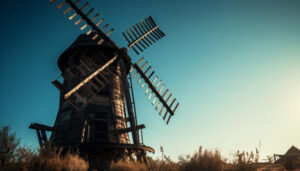The medieval era, often regarded as a time of knights, castles, and feudalism, was also marked by remarkable technological achievements that laid the foundation for future advancements.
In this article, we delve into the fascinating world of medieval ingenuity, exploring inventions like windmills, clocks, eyeglasses, and the compass, which transformed various aspects of daily life.
Medieval Marvels: Harnessing the Power of the Wind – Windmills

Medieval Marvels Windmill
The Flourishing Grind of Windmills
During the medieval period, the landscape of Europe began to transform with the emergence of windmills. Initially designed for grinding grains, these towering structures became a symbol of agricultural productivity. Windmills harnessed the power of the wind to turn massive grinding stones, streamlining the production of flour and other essential commodities. This innovation not only enhanced food production but also allowed communities to thrive by efficiently processing raw materials.
Evolving Functions – Beyond Grains and Grist
As technology advanced, so did the functionality of windmills. They evolved from simple grain mills to versatile machines capable of pumping water, sawing wood, and even generating mechanical power for various industrial tasks. The adaptability of windmills showcased the creativity of medieval engineers, providing solutions to challenges faced by both rural and urban communities.
Medieval Marvels: Windmills in the Modern Context
While windmills have evolved into sleek, modern wind turbines, the basic principle remains the same – harnessing wind energy for productive purposes. The medieval windmill, with its simple yet ingenious design, set the stage for the development of renewable energy technologies that continue to shape our modern world.
Medieval Marvels – The Mechanical Marvels of Clocks

Medieval Marvels Clocks
The Rise of Mechanical Timekeeping
In medieval Europe, the concept of measuring time with precision took a giant leap forward with the development of mechanical clocks. Initially installed in churches to regulate prayer times, these early clocks marked the beginning of a structured approach to timekeeping. The gears and escapements of these medieval timepieces paved the way for the accurate clocks and watches we use today.
From Church Towers to Town Squares
As the demand for accurate timekeeping grew, mechanical clocks transcended the confines of church towers and found their way into town squares and public spaces. The distinctive chimes of these clocks not only regulated daily activities but also became integral to the rhythm of medieval urban life. The mechanical clock, with its visible gears and rotating hands, became a symbol of technological sophistication.
Medieval Marvels: Legacy in Horology
The legacy of medieval mechanical clocks endures in the intricate timepieces and watches of the present day. The principles of escapements, gears, and pendulums developed during the medieval era laid the groundwork for the intricate movements and precision we now expect in our timekeeping devices. The medieval clockmakers, with their innovative spirit, unknowingly shaped the very fabric of our modern schedules.
Medieval Marvels – The Optical Advancement of Eyeglasses

Medieval Marvels Eyeglasses
A Clearer View with Eyeglasses
One of the most impactful inventions of the medieval era was the advent of eyeglasses. Emerging in the 13th century, eyeglasses revolutionized the lives of individuals with visual impairments, offering a clearer and more focused view of the world. Craftsmen, scholars, and individuals from all walks of life benefited from this optical marvel.
Craftsmanship and Vision Enhancement
Medieval eyeglasses were crafted with meticulous care, often featuring frames made of materials like bone or metal. The lenses, ground by skilled artisans, provided a solution for farsightedness, near-sightedness, and presbyopia. The widespread use of eyeglasses contributed to increased productivity, particularly in fields that demanded precision and attention to detail.
Medieval Marvels: Beyond the Medieval Forge – Eyeglasses Today
The medieval innovation of eyeglasses has evolved into a massive industry catering to diverse vision needs. Modern lenses are made with precision using advanced materials, and frames are designed for comfort and style. The journey from rudimentary lenses in medieval times to cutting-edge optics today is a testament to the enduring impact of this medieval technological marvel.
Medieval Marvels – List of 4 Technological Achievements:
- Windmills: Windmills were significant technological achievements during the medieval period. Initially used for grinding grain, they later evolved to pump water and perform various industrial tasks. Windmills played a crucial role in agricultural productivity and resource management.
- Clocks and Mechanical Timekeeping: The development of mechanical clocks in medieval Europe represented a breakthrough in timekeeping technology. Initially installed in churches, these clocks evolved into more sophisticated designs, including astronomical clocks. Mechanical timekeeping devices played a crucial role in regulating daily activities and became essential in various societal functions.
- Eyeglasses: Eyeglasses, or spectacles, became prevalent in medieval Europe by the 13th century. This invention significantly improved vision for individuals with visual impairments, enhancing the quality of life for scholars, craftsmen, and the general population. The use of eyeglasses marked a notable advancement in optics during the medieval period.
- The Compass: While the compass was known in ancient China, its adoption in medieval Europe had a profound impact on navigation. Mariners used compasses to determine direction at sea, making long-distance maritime exploration and trade more feasible. This technological advancement contributed to the Age of Discovery and the expansion of trade routes during the medieval era.
These medieval technological achievements reflect the ingenuity and innovation of the time, laying the groundwork for advancements that would shape the course of history in subsequent centuries.
Medieval Marvels Conclusion
The medieval era, often overshadowed by tales of chivalry and knights, was a crucible of technological innovation.
Windmills, clocks, eyeglasses, and the compass were not only ingenious solutions to everyday challenges but also stepping stones towards the technological landscape we inhabit today.
As we marvel at the complexities of our modern world, let us not forget the ingenious minds of medieval times that set the stage for the technological marvels of the present.










